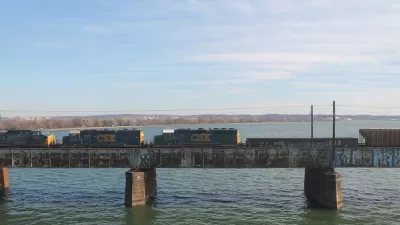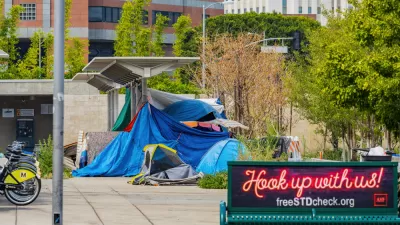Even as extensions to the Gold Line and Measure S seem to paint a brighter future for public transit in Los Angeles, commuters continue to use less public transit, especially buses.

"Since 2009, Metro has opened four new rail extensions at a cost of more than $4 billion. In the same period, rail ridership soared 21%, but bus trips — a much larger share of overall ridership — dropped 18%," writes Laura J. Nelson for the Los Angeles Times.
The reasons for the shrinking use of transit are multiple, according to Nelson's reporting. One is the complexity of serving a city with so many different commerce centers, which requires compromises in bus service. "But tweaks over the years to routes and schedules may have eroded the efficiency of some workhorse bus lines that serve major corridors, or made the routes more confusing for riders," Nelson writes. Nelson also reports that some transit experts see falling bus ridership as a side effect of an improving economy. "As L.A.’s economy has steadily improved, traffic has grown worse, and so has Metro’s on-time performance. Agency figures show that about 76% of buses arrived on time in the 2014 fiscal year." Ride sharing services may be partly to blame as well.
One reason for the decline in bus ridership Nelson does not cite is zoning and density. There's been much talk about how although L.A.'s downtown is becoming more popular, it's hard to build large dense transit-friendly buildings in the city. This phenomenon is noticeable by how few cranes you see in the city's downtown compared to even smaller, slower-growing cities like Chicago. Density continues to be on the minds of many as Measure S and the possibility of stalling the construction of more and taller residential and business buildings looms.
FULL STORY: The Metro can take you farther than ever. Here's why ridership dropped — again

Planetizen Federal Action Tracker
A weekly monitor of how Trump’s orders and actions are impacting planners and planning in America.

Maui's Vacation Rental Debate Turns Ugly
Verbal attacks, misinformation campaigns and fistfights plague a high-stakes debate to convert thousands of vacation rentals into long-term housing.

Restaurant Patios Were a Pandemic Win — Why Were They so Hard to Keep?
Social distancing requirements and changes in travel patterns prompted cities to pilot new uses for street and sidewalk space. Then it got complicated.

In California Battle of Housing vs. Environment, Housing Just Won
A new state law significantly limits the power of CEQA, an environmental review law that served as a powerful tool for blocking new development.

Boulder Eliminates Parking Minimums Citywide
Officials estimate the cost of building a single underground parking space at up to $100,000.

Orange County, Florida Adopts Largest US “Sprawl Repair” Code
The ‘Orange Code’ seeks to rectify decades of sprawl-inducing, car-oriented development.
Urban Design for Planners 1: Software Tools
This six-course series explores essential urban design concepts using open source software and equips planners with the tools they need to participate fully in the urban design process.
Planning for Universal Design
Learn the tools for implementing Universal Design in planning regulations.
Heyer Gruel & Associates PA
JM Goldson LLC
Custer County Colorado
City of Camden Redevelopment Agency
City of Astoria
Transportation Research & Education Center (TREC) at Portland State University
Jefferson Parish Government
Camden Redevelopment Agency
City of Claremont





























